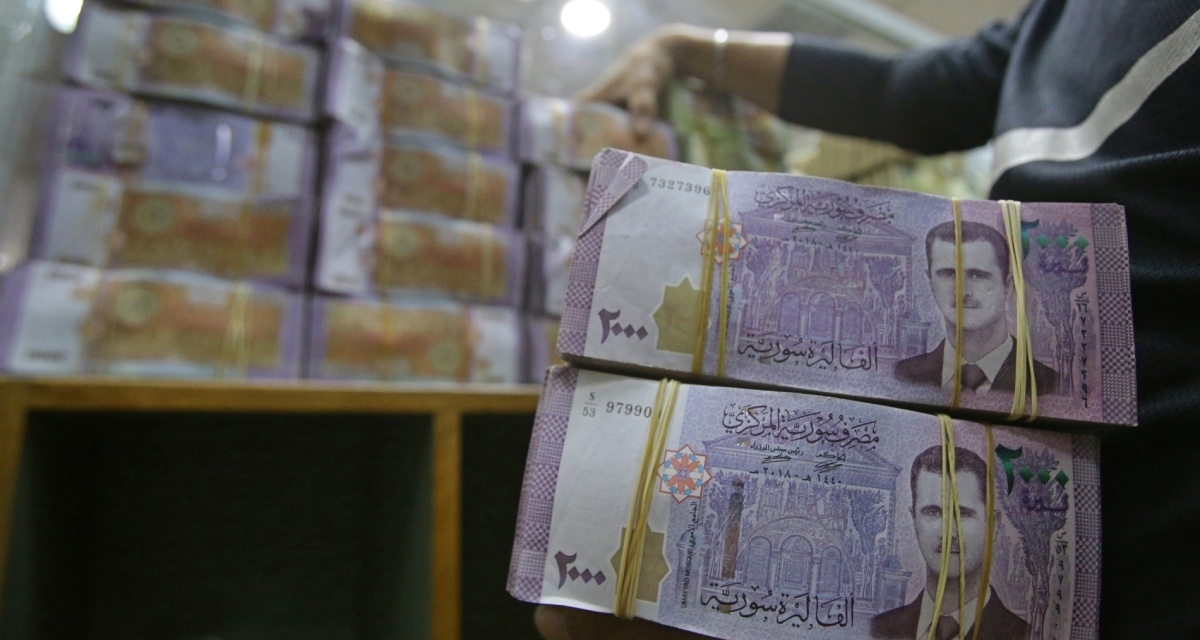An employee piles up stacks of banknotes at the Commercial Bank of Syria, Damascus, November 10, 2022 (Louai Beshara/AFP/Getty)
After almost 13 years of repression of Syria’s uprising, killing hundreds of thousands of civilians and displacement of millions, the Assad regime is presiding over a fragmented country and an economy in free fall.
Syria Direct documents the dark prospects for the country in 2024. While noting that those in opposition-held parts of the northwest and the Kurdish-controlled area in the northeast also face worsening conditions, it assesses, “The reality in regime-held territories, the majority of the country, is the most dire.”
Following more than a decade of isolation over its war crimes, the regime proclaimed “normalization” throughout 2023, with the restoration of bilateral relations with some Middle Eastern and North African countries and re-entry into the Arab League.
However, the political shift has not been accompanied by economic opportunity. Instead, the Syrian currency has plunged to a new historic low; the regime has been forced to cut subsidies on fuel and other essentials; and more citizens have left the country, joining more than 5.1 million registered refugees.
At the start of the uprising in March 2011, the pound was 47:1 v. the US dollar. On January 1, it stood at 14,000:1, having lost 41% of its value in 2022 and 56% in 2023.
Manaf Quman of the Turkey-based Omran Center for Studies, notes, “The value of Syrian currency has become less than it costs to print it.”
“How Bad Things Get Cannot Be Determined”
The regime is still unable to attract foreign revenue through investment and trade and is further limited by international sanctions. Trying to deal with rising prices by printing more currency, to cover a doubling in public sector salaries, it has only added to the inflationary pressure: January 2023’s rate of 89% year-on-year has continued into 2024, and the cost of food more than doubled between January and September 2023.
In September, the average monthly cost of living for a Syrian family of five was SYP 9.5 million ($673), almost 50% higher than July’s SYP 6.5 million ($460). The minimum cost of living rose from SYP 4.1 million ($290) in July to SYP 5.9 million in September ($418). In comparison, minimum wage was SYP 185 million ($13) — 2% of the minimum cost of living.
About 90% of Syrians now live below the poverty level. More than 15 million — 65% of the population— need humanitarian assistance. But in September, the UN’s World Food Programme suspended general aid because of its budgetary difficulties.
Karam Shaar of the Observatory of Political and Economic Networks says the situation is “the worst since the beginning of the 20th century”. The responsibility lies with the regime “as a result of its continued encroachment on various economic activities to ensure its survival, in addition to other factors such as the decrease in humanitarian aid and decrease in private economic activities”.
Bashar al-Assad acknowledged, in an interview in late September with China Central Television, “Let us be clear, it is a bad situation and suffering is increasing.”
However, rather than discussing internal issues including corruption and mismanagement, he put all the blame of the “West” over sanctions, including on him and his inner circle.
Manaf Quman evaluates:
So long as the ingredients of the economic crisis are there, and the situation goes from bad to worse, prices will continue to rise continuously, and the pound to fall….
The threshold of how bad things get cannot be determined.
Shaar agrees, “The regime rejects any political move that would lead to a political settlement resulting in the lifting of sanctions and return of capital, [so] things will continue to take a turn for the worse.”

